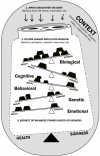Pathways to health: a framework for health-focused research and practice
- PMID: 17164004
- PMCID: PMC1713229
- DOI: 10.1186/1742-7622-3-18
Pathways to health: a framework for health-focused research and practice
Abstract
Public health research and practice is faced with three problems: 1) a focus on disease instead of health, 2) consideration of risk factor/disease relationships one at a time, and 3) attention to individuals with limited regard for the communities in which they live. We propose a framework for health-focused research and practice. This framework encompasses individual and community pathways to health while incorporating the dynamics of context and overall population vulnerability and resilience. Individual pathways to health may differ, but commonalities will exist. By understanding these commonalities, communities can work to support health-promoting pathways in addition to removing barriers. The perspective afforded by viewing health as a dynamic process instead of as a collection of risk factors and diseases expands the number of approaches to improving health globally. Using this approach, multidisciplinary research teams working with active community participants have the potential to reshape health and intervention sciences.
Figures

References
-
- Smedley BD, Syme SL, Institute of Medicine (U.S.). Committee on Capitalizing on Social Science and Behavioral Research to Improve the Public's Health . Promoting health intervention strategies from social and behavioral research. Washington, D.C. , National Academy Pr.; 2000. p. xiv, 493. - PubMed
LinkOut - more resources
Full Text Sources

